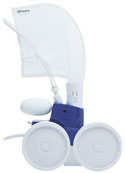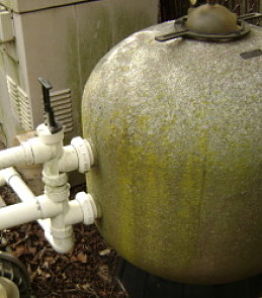Solving pool problems since 1985!
Pool Maintenance Mistakes
1. Neglecting the pool water chemistry.
Many pool owners mistakenly believe that if their pool water is clear and algae free, then the water is properly balanced. NOT true. We have seen hundreds of pools that look clear, but the ph, alkalinity, stablizer, and hardness are all out of adjustment.
Clear water that is out of balance can not only damage your pool and equipment, but can also be very uncomfortable for swimmers. Unbalanced water can cause skin and eye irritation.
Some people have told us that all they worry about is the chlorine reading. BIG MISTAKE! If you don't want to learn about ph, alkalinity, stablizer, hardness and how to balance pool water, give us a call and we will do it for you on a weekly basis.
If you want to learn how to test the water yourself, get a Taylor test kit. The professional model that all of our service techs use and it's the one you need unless you plan to be making trips back and forth to your local pool store.
The smaller version of the Taylor test kit has most of what you need but does not give you a way to test stablizer (conditioner) which is a very important test that you must do or have done for you anytime your pool is not holding chlorine.
It also does not have a way to test calcium hardness.
2. Allowing the water level to fall too low in the pool.
When the water gets too low in the pool, the pump begins to suck in air through the skimmer instead of water, causing the pump to loose prime. (Loosing prime means the pump is running but water has stopped moving through it). Sometimes the pump will re-prime after a few moments and begin pumping briefly until it sucks more air through the skimmer causing a loss of prime again. The cycle repeats again and again, or the pump looses prime completely and sits there running "hot and dry". This can damage the pump, cause pumps to begin leaking, or ruin the motor.
The correct water level is half way up in the opening of the skimmer which is usually half way up on the tile in a gunite pool.
3. Over-filling the pool.
Back yards are flooded every year by people forgetting that the water hose is on in the pool. One way to avoid this is to set an alarm that will alert you at the desired time instead of hoping you remember to shut off the water.
The best way our pool techs have found is to hook their truck keys to the water faucet to remind themselves not to drive off with the water running.
Another method is to never submerge the end of the garden hose in the pool. Instead, place a weight on the hose so that it is suspended a few inches abover the water so you can hear the sound of the water flowing into the pool.
A fourth method is to buy a pool water filling tool that attaches to a garden hose and shuts off automatically when the pool reaches the desired level.
4. Not running the pump enough hours.
You may save a little money on electricity by running your pump for only 4-6 hrs during the heat of the summer, but you will pay for it in lost swimming time and frustration when your pool gets algae.
As a rule of thumb, we tell people to run their pumps at least 10-14 hrs per day during the summer, and cut the time in half during the cold times of the year (if the pool pump is not winterzed). If the temperature is below freezing, the pump should run 24/7 if not winterized.
If you know how many gallons per minute (gpm) your pump is pumping, this is the correct way to calculate pump run times for the summer. Pump gpm x 60 minutes = gallons per hour (gph) Pool gallons / gph = hours per day to run the pump
Example: 30,000 gal pool; 48 gpm pump
48 gpm x 60 min = 2800 gph
30,000 gal / 2800 gph = 10.41 hrs/day pump run time.
5. Running the pump too many hours.
Running your pump 24 hrs/ day when it only needs 12 hrs/ day is only wasting your electricity and causing the pump to wear out faster. (Read point #4 above for correct pump run time).
6. Running the Polaris booster pump all the time.
If you have a Polaris automatic pool cleaner, it can probably keep your pool clean running only part of the time that your main pump is running. For example, if your main pump is running 12 hrs/day, you may find that running your Polaris booster pump for 6 of those hours is sufficient. Experiment and find out what works best for you.
If you are running your booster pump twice as long as you need to, your Polaris is going to wear out twice as fast and your electric bill is going to be inflated as well!

7. Buying a slide valve instead of a multi-port valve.
The slide valve or 2 position valve for sand filters, is not very versatile. You only have 2 options with this valve....either backwash or filter.
What if you need to vacuum to waste? No problem if you have a multi-port valve, but if you have a slide valve, you will need a portable waste pump or have an exit port valve plumbed into the PVC pipe that connects the pump to the filter. Either way, it's an extra expense and a hassle.
Give us a call if you would like to have a multi-port valve or an exit port valve installed. If there is enough room around your filter, one of these 2 options may work for you.
Pictured below is a sand filter with a 2 Position Valve.

8. Misunderstanding the Salt Water pool.
Many pool owners that we talk to don't understand that their salt water pool has a system that is converting the salt to chlorine. They still have a chlorine based sanitizing system and the water still needs to be tested and balanced on a regular basis like any other pool. (See point #1 above.)
Some salt water chlorine generator owners think that all they have to do is add salt. NOT TRUE!
9. Turning off the pool pump while the heater is burning hot.
If your heater is burning hot and you turn your pool pump off, the water inside the heat exchanger within the heater can get boiling hot which can lead to softening and bending hard PVC pipes attached to the heater. This can cause leaks and cost you some repair dollars.
Always turn your heater burners off and let the pool pump continue to circulate for several minutes before turning off the pool pump. This will give the heat exchanger time to be cooled down by the water flowing through the pipes.
Click here to go to "Pool Cleaning Mistakes".
Click here to return to the Home page.